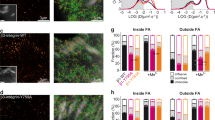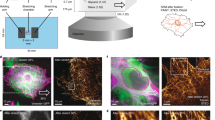Abstract
The extracellular matrix (ECM) activates signalling pathways that control cell behaviour by binding to cell-surface integrin receptors and inducing the formation of focal adhesion complexes (FACs)1,2. In addition to clustered integrins, FACs contain proteins that mechanically couple the integrins to the cytoskeleton3 and to immobilized signal-transducing molecules1,2. Cell adhesion to the ECM also induces a rapid increase in the translation of pre-existing messenger RNAs4,5. Gene expression can be controlled locally by targeting mRNAs to specialized cytoskeletal domains6. Here we investigate whether cell binding to the ECM promotes formation of a cytoskeletal microcompartment specialized for translational control at the site of integrin binding. High-resolution in situ hybridization revealed that mRNA and ribosomes rapidly and specifically localized to FACs that form when cells bind to ECM-coated microbeads. Relocation of these protein synthesis components to the FAC depended on the ability of integrins to mechanically couple the ECM to the contractile cytoskeleton and on associated tension-moulding of the actin lattice. Our results suggest a new type of gene regulation by integrins and by mechanical stress which may involve translation of mRNAs into proteins near the sites of signal reception.
This is a preview of subscription content, access via your institution
Access options
Subscribe to this journal
Receive 51 print issues and online access
$199.00 per year
only $3.90 per issue
Buy this article
- Purchase on Springer Link
- Instant access to full article PDF
Prices may be subject to local taxes which are calculated during checkout




Similar content being viewed by others
References
Plopper, G., McNamee, H. P., Dike, L. E., Bojanowski, K. & Ingber, D. Convergence of integrin and growth factor receptor signaling pathways within the focal adhesion complex. Mol. Biol. Cell. 6, 1349–1365 (1995).
Miyamoto, S. et al. Integrin function: molecular hierarchies of CSK and signaling molecules. J. Cell Biol. 131, 791–805 (1995).
Wang, N. J., Butler, P. & Ingber, D. E. Mechanotransduction across the cell surface and through the CSK. Science 260, 1124–1127 (1993).
Benecke, B.-J., Ben-Ze'ev, A., Benecke, B.-J. & Penman, S. The control of mRNA production, translation and turnover in suspended and reattached anchorage-dependent fibroblasts. Cell 14, 931–939 (1978).
Farmer, S. R., Ben-Ze'ev, A. & Penman, S. Altered translatability of messenger RNA from suspended anchorage-dependent fibroblasts: reversal upon cell attachment to a surface. Cell 15, 627–637 (1978).
Bassell, G. & Singer, R. H. mRNA and cytoskeletal filaments. Curr. Opin. Cell Biol. 9, 109–115 (1997).
Plopper, G. & Ingber, D. E. Rapid induction and isolation of focal adhesion complexes. Biochem. Biophys. Res. Commun. 193, 571–578 (1993).
Latham, V., Kislauskis, E., Singer, R. & Ross, A. β-Actin mRNA localization is regulated by signal transduction mechanisms. J. Cell Biol. 126, 1211–1219 (1994).
Taneja, K. L., Lifshitz, L. M., Fay, F. S. & Singer, R. H. Poly(A) RNA codistribution with microfilaments: Evaluation by in situ hybridization and quantitative digital imaging microscopy. J. Cell Biol. 119, 1245–1260 (1992).
Bassell, G. J., Powers, C. M., Taneja, K. L. & Singer, R. H. Single mRNAs visualized by ultrastructural in situ hybridization are principally localized at actin filament intersections in fibroblasts. J. Cell Biol. 126, 863–876 (1994).
Ingber, D. E. Cellular tensegrity: defining new rules of biological design that govern the cytoskeleton. J.Cell Sci. 104, 613–627 (1993).
Wang, N. & Ingber, D. E. Probing transmembrane mechanical coupling and cytomechanics using magnetic twisting cytometry. Biochem. Cell Biol. 73, 327–335 (1995).
Cramer, L. P. & Mitchison, T. J. Myosin is involved in postmitotic cell spreading. J. Cell Biol. 131, 179–189 (1995).
Nakanishi, S., Yamada, K., Iwahashi, K., Kuroda, K. & Kase, H. KT5926, a potent and selective inhibitor of myosin light chain kinase. Mol. Pharmacol. 37, 482–488 (1990).
Long, R. M. et al. Mating type switching in yeast controlled by asymmetric localization of ASH1 mRNA. Science 277, 383–387 (1997).
Chrzanowska-Wodnicka, M. & Burridge, K. Rho-stimulated contractility drives the formation of stress fibers and focal adhesions. J. Cell Biol. 133, 1403–1415 (1996).
Ingber, D. E. et al. Control of intracellular pH and growth by fibronectin in capillary endothelial cells. J. Cell Biol. 110, 1803–1811 (1990).
Edmonds, B. T., Murray, J. & Condeelis, J. pH regulation of the F-actin binding properties of Dictyostelium elongation factor 1a. J. Biol. Chem. 270, 15222–15230 (1995).
Vuori, K. & Ruoslahti, E. Activation of protein kinase C precedes α5β1 integrin-mediated cell spreading on FN. J. Biol. Chem. 268, 21459–21462 (1993).
Morley, S. J. Signal transduction mechanisms in the regulation of protein synthesis. Mol. Biol. Rep. 19, 221–231 (1994).
Whalen, S. G. et al. Phosphorylation of eIF-4E on serine 209 by protein kinase C is inhibited by the translational repressors, 4E-binding proteins. J. Biol. Chem. 271, 11831–11837 (1996).
Von Manteuffel, S., Gingras, A. C., Ming, X. F., Sonenberg, N. & Thomas, G. 4E-BP1 phosphorylation is mediated by the FRAP-p70s6k pathway and is independent of mitogen-activated protein kinase. Proc. Natl Acad. Sci. USA 93, 4076–4080 (1996).
Sonenberg, N. Regulation of translation and cell growth by eIF-4E. Biochimie 76, 839–846 (1994).
Singh, N. K., Attreya, C. D. & Nakhasi, H. L. Identification of calreticulin as a rubella virus RNA binding protein. Proc. Natl Acad. Sci. USA 91, 12770–12774 (1994).
Schmeichel, K. L. & Beckerle, M. C. Molecular dissection of a LIM domain. Mol. Biol. Cell. 8, 219–230 (1997).
Wada, H., Ivester, C. T., Carabello, B. A., Cooper, G. & McDermott, P. J. Translational initiation factor eIF-4E. A link between cardiac load and protein synthesis. J. Biol. Chem. 271, 8359–8364 (1996).
Kourembanas, S., Hannan, R. L. & Faller, D. V. Oxygen tension regulates the expression of the platelet-derived growth factor-B chain in human endothelial cells. J. Clin. Invest. 86, 670–674 (1990).
Lucas, J. J., Szekely, E. & Kates, J. R. The regeneration and division of mouse L-cell karyoplasts. Cell 7, 115–122 (1976).
Schwartz, M. A., Lechene, C. & Ingber, D. E. Insoluble FN activates the Na+/H+ antiporter by clustering and immobilizing integrin alpha 5 beta 1, independent of cell shape. Proc. Natl Acad. Sci. USA 88, 7849–7853 (1991).
Zhang, G., Taneja, K. L., Singer, R. H. & Green, M. R. Localization of pre-mRNA splicing in mammalian nuclei. Nature 372, 809–812 (1994).
Acknowledgements
We thank K. Taneja, S. Shenoy, N. Wang, J. Fredberg, S. Kourembanas, G. Lee, G.Whitesides and the Biomedical Imaging Facility at the University of Massachusetts in Worcester for key reagents, equipment and technical expertise, and B. Peters and C. Chen for discussion. This work was supported by grants from the NIH and NASA and an American Cancer Society postdoctoral fellowship.
Author information
Authors and Affiliations
Corresponding author
Rights and permissions
About this article
Cite this article
Chicurel, M., Singer, R., Meyer, C. et al. Integrin binding and mechanical tension induce movement of mRNA and ribosomes to focal adhesions. Nature 392, 730–733 (1998). https://doi.org/10.1038/33719
Received:
Accepted:
Issue Date:
DOI: https://doi.org/10.1038/33719
This article is cited by
-
OVOL2 impairs RHO GTPase signaling to restrain mitosis and aggressiveness of Anaplastic Thyroid Cancer
Journal of Experimental & Clinical Cancer Research (2022)
-
A 10-gene prognostic signature points to LIMCH1 and HLA-DQB1 as important players in aggressive cervical cancer disease
British Journal of Cancer (2021)
-
Intracellular mRNA transport and localized translation
Nature Reviews Molecular Cell Biology (2021)
-
Translational control of stem cell function
Nature Reviews Molecular Cell Biology (2021)
-
The skeletal muscle fiber: a mechanically sensitive cell
European Journal of Applied Physiology (2019)
Comments
By submitting a comment you agree to abide by our Terms and Community Guidelines. If you find something abusive or that does not comply with our terms or guidelines please flag it as inappropriate.



